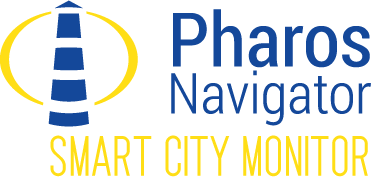Enriching and enhancing Citizens life

The Smart City Monitor is the open digital transformation platform for local communities to make its processes transparent, introduce new services into their daily life, enhance and enrich its content. It provides effective novel tools for citizens and businesses to access real time evidence information improving quality of life and decisions, assisting in various routine activities and relations between the Citizens and their City.
The ongoing rich information about diverse urban processes and its aggregated results becomes available online in real time. It can be accessed accordingly to interests and rights by rich variety of options such as personal online web and mobile applications in dashboards, maps, diagrams, charts, various widgets and reports presenting the City Life. In all these cases the information is interactive and available in real time for everyone accordingly to the data access policies set by local governance bodies.
Receiving the personal information about various aspects of ongoing city life
There are many smart options providing citizens and businesses with information for their daily life. Here are some examples in more detail:
Smart walking in the city: Citizens and tourists ask their mobile app to find the optional routes according to their preferences e.g. one park, one café, two different types of shops, one museum, etc. Alternatively they can set preferences such as “I have 2 hours and want to visit several places where my kid can play for 20-30 minutes, show me the options!”, and many others such as walking with elderly and persons with disabilities, dogs, etc. While on the route each person will be notified to their mobiles by Smart City Monitor immediately if some events will take place during the walk in the locations that are close to the route (e.g. sharp increase of air pollution, accidents, fires, acts of terror, etc).
Finding services or resources: Citizens and tourists can find necessary active performing services or resources in the city anytime e.g. within some distance from the target location. The information includes current status and details of processes taking places in the service or object of interest and relevant latest events.
The information is made available by the private and public service providers e.g. services shops, repair businesses, etc as well as city administration and reveal current service status like ”Open” or “Closed” along with the concrete quantitative details about the service performance at the moment of inquiry e.g.
- Our restaurant has now 7 free tables and 5 free parking slots now. (Timestamp: 19:45:21 2015-09-28”). The same type of information can be provided by other services e.g. fast repair service, sport events, public concerts, etc)
- The estimating number of people in the queue is 19. The expected waiting time is 20 min. (Timestamp: 19:45:21 2015-09-28)
- We have now 5 cashers serving our customers with average waiting time 1,5 min. (Timestamp: 19:45:21 2015-09-28)
- Actual number of students per one teacher in mathematics in the school “Y” today is 19”
- The number of passengers in our public transportation system at this moment of time 2,463.
Quick Med Service information
- Number specialists in department “Blood tests” on service today are 2.
- Lag time between analysis and availability of results is 13 min. (Timestamp: 19:45:21 2015-09-28)
Online inquiries regaring currently avalable services (examples):
- Where are parking places with at least 3 free slots available now near that particular location Lang/Long? What are the prices in each place? (the citizen clicks on city map or use own mobile phone to identify own location)
- Where are the hotels with at least 1 double room within 1 km from the location with the Latitude and Longitude? What are prices?
- When and where kids events for ages between 7 and 10 will take place during next week end?
- What is the status of activities and performance in this public service (e.g. school, hospital, fire brigade, etc)?
Integrated performance of city services can be presented in hundreds of various indicators that include both local ones as well as those recommended by international standards such as ISO 37120, 37122, etc. The specific examples could be as follows:
- The current use of water per person in our city (or by each of its districts) is 309,3 liters/person per month, it is above the level of sustainable water supply which is 290 liters/person per month and above national average of 301,23 liters/person/month
- Current number of busses which serve you in our city is 99 with average of 7 persons used them each day.
- The average costs of the bus transportation services per such person is 1,23 Euro per day
and so on. The Smart City monitor allows easy and quick creation and modification of any necessary indicator and its adding to the public and administrative information services. The level of details in such information is limited only by available data from particular service provider. It may include any detail decided by the data provider and its relevant technical facilities e.g. video streams to performance data illustrating on-going services, sales, and related parking places, etc.
City transportation departments can provide own public performance data regarding key transportation routes, number of passengers and traffic congestions on particular street/crossroads, public transport service levels on the City Life map and mobile apps.
Checking actual arrival time for the next passenger vehicle (bus, train, etc): The citizens who plan to commute or wait for a bus may have online information about actual expected arrival of the bus to particular place or stop and expected transfer time. It could be important information in many real life cases considering bad weather options, day time, and various public events in the city which may influence changes in generic route schedule.
Checking authorization for public works: Citizens can easily check online if particular city activities were authorized by the city administration e.g. road repair on crossroad streets X/Y, water pipe maintenance, cabling in location Z, bus route change, visits of relevant service representatives to their houses, etc. As option the citizens can be offered to provide relevant comments to city administration in standard online evaluation forms which allows having evaluation of results, its automatic processing and adding to the city performance dashboards.
Obtaining automatic notifications about walking, bicycling, other traffic status: While moving on the specific routes the persons and drivers may be automatically warned about congestions and advised with rerouting options.
Knowing what’s going on: by subscribing for city events and news using the tags as topics of interest the citizens can obtain focused information e.g.
- Inform me about events for children age 7-10 which are related to games, performances, and violin.
- I want to have all information about city fireworks, fun & entertainments within next week.
- Let me know when there are free places in sport club X, etc.
The subscriber will be notified automatically when any event organizer publishes its plan of performances. The service event providers are authorized and monitored by the City administration.
Sharing the knowledge of citizens
The city platform provides the citizens and the City with instruments to share their knowledge in the interests of community and contribute to city life. It may include the following:
Sending notification and proposal about identified problems as major issues of concern for residents, e.g. abandoned urban spaces, road pits, fallen tree, cable, water leak, street light on during daytime, unregistered repair service in the building or on road, accident, fire, fight, crime, etc.
The technical implementation is easy and simple: Make picture by own mobile with GPS geolocation, identify problem tag, add possible text or voice comments and send the event to the Smart City server for prompt processing and response actions by relevant City management.
Posting information about thematic community events, e.g. formal and informal meetings, food markets (subject to City publication policies) with automatic notifications to all subscribers.
Crowd sourcing data: Along with environmental measurements made by city and official state agencies the citizens can use own low-cost sensors e.g. IoT to measure their local environments and stream the measurement data to the maps of City Life contributing to open data. The new variety of new sensoring application options in mobile phones and add-on devices can supplement to city-wide sensor networks.
Viewing city environmental and safety dimensions
Smart City Monitor allows effective analysis and presentation of environmental and safety and security situation in their urban and metropolitan areas. It includes maps of pollution such as NOx, CO2 or noise, traffic, accidents and congestions, abnormal events, etc based on available measurement data sets and sensor locations e.g. in residence areas, kindergartens, schools, sport facilities, etc.
The mapping feature helps citizens viewing any open data available in the city's information bases including historic data and its change overtime, various events, animations of real city developments and growth. By using mobile apps citizens and tourists can be automatically notified about specific events and abnormalities related to the place of their current location e.g. while shopping, walking, travelling throughout the city linked to their Smart City Monitor
Collective intelligence: The platform supports citizens getting involved in policymaking, planning and budgeting, helping make smarter and more democratic decisions in local governance. It facilitates problem solving by citizens using online tools that let people debate ideas and decide which of them get implemented rather than simply asking for suggestions.
Community projects and city governments can use the instruments for crowd funding of collaboratively formulated and selected projects to make spending decisions that more accurately reflect the needs and wishes of citizens.
Citizens can access open data and finding productive uses for the data to create innovative solutions to urban challenges, bringing businesses, community groups and city governments together to develop new ways of using city data.
The spirit of confidence
The implementation of Smart City Monitor as official source of the City Life performance and events increases confidence by citizens and tourists, quality and culture of business services and attract investors
All these examples present only minor number of options which can be realized by the integrated Smart City Monitor solution.
2025 © GOLEM IMS GMBH, Austria. ALL Rights Reserved.
Terms of Service |
Privacy Policy
Made in Austria

